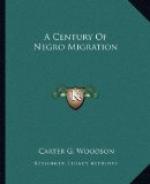Free Negroes had voted in all the colonies except Georgia and South Carolina, if they had the property qualification; but after the sentiment attendant upon the struggle for the rights of man had passed away there set in a reaction.[2] Delaware, Maryland, Virginia and Kentucky disfranchised all Negroes not long after the Revolution. They voted in North Carolina until 1835, when the State, feeling that this privilege of one class of Negroes might affect the enslavement of the other, prohibited it. The Northern States, following in their wake, set up the same barriers against the blacks. They were disfranchised in New Jersey in 1807, in Connecticut in 1814, and in Pennsylvania in 1838. In 1811 New York passed an act requiring the production of certificates of freedom from blacks or mulattoes offering to vote. The second constitution, adopted in 1823, provided that no man of color, unless he had been for three years a citizen of that State and for one year next preceding any election, should be seized and possessed of a freehold estate, should be allowed to vote, although this qualification was not required of the whites. An act of 1824 relating to the government of the Stockbridge Indians provided that no Negro or mulatto should vote in their councils.[3]
That increasing prejudice was to a great extent the result of the immigration into the North of Negroes in the rough, was nowhere better illustrated than in Pennsylvania. Prior to 1800, and especially after 1780, when the State provided for gradual emancipation, there was little race prejudice in Pennsylvania.[4] When the reactionary legislation of the South made life intolerable for the Negroes, debasing them to the plane of beasts, many of the free people of color from Virginia, Maryland and Delaware moved or escaped into Pennsylvania like a steady stream during the next sixty years. As these Negroes tended to concentrate in towns and cities, they caused the supply of labor to exceed the demand, lowering the wages of some and driving out of employment a number of others who became paupers and consequently criminals. There set in too an intense struggle between the black and white laborers,[5] immensely accelerating the growth of race prejudice, especially when the abolitionists and Quakers were giving Negroes industrial training.
The first exhibition of this prejudice was seen among the lower classes of white people, largely Irish and Germans, who, devoted to menial labor, competed directly with the Negroes. It did not require a long time, however, for this feeling to react on the higher classes of whites where Negroes settled in large groups. A strong protest arose from the menace of Negro paupers. An attempt was made in 1804 to compel free Negroes to maintain those that might become a public charge.[6] In 1813 the mayor, aldermen and citizens of Philadelphia asked that free Negroes be taxed to support their poor.[7] Two Philadelphia representatives in the Pennsylvania Legislature had a committee appointed in 1815 to consider the advisability of preventing the immigration of Negroes.[8] One of the causes then at work there was that the black population had recently increased to four thousand in Philadelphia and more than four thousand others had come into the city since the previous registration.




